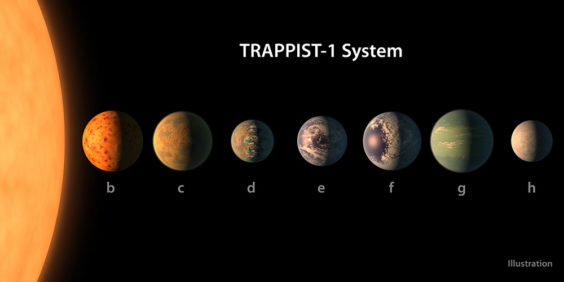Re Ian Bremmer 'Could third-party candidates upend the 2024 US election?' 3 April The current political movement in the USA…
Space: the final frontier 2016-April 2021
Written by Diana Thebaud Nicholson // April 28, 2021 // Aviation & Aerospace, Science & Technology // Comments Off on Space: the final frontier 2016-April 2021
See also NASA
Space news
European Space Agency (ESA) Rosetta Overview
Mars ; space.com
The Hubble Deep Field:
The Most Important Image Ever Taken (480p HD)
Apollo 11 Moon Landing: Photos From 50 Years Ago
The World’s Richest Men Are Brawling Over the Moon
NASA gave Elon Musk’s SpaceX a coveted contract for a lunar mission. Jeff Bezos plans to fight for it.
23 April
SpaceX rocketship launches 4 astronauts on NASA mission to space station
NASA and Elon Musk’s commercial rocket company SpaceX launched a new four-astronaut team on a flight to the International Space Station on Friday, the first crew ever propelled into orbit by a rocket booster recycled from a previous spaceflight.
The company’s Crew Dragon capsule Endeavour, also making its second flight, streaked into the darkened pre-dawn sky atop a SpaceX Falcon 9 rocket as its nine Merlin engines roared to life at 5:49 a.m. (0949 GMT) from NASA’s Kennedy Space Center in Florida.
The crew is due to arrive at the space station, orbiting some 250 miles (400 km) above Earth, early on Saturday following a flight of about 23 hours.
21 April
NASA’s Perseverance Mars Rover Extracts First Oxygen From Red Planet
(NASA) The growing list of “firsts” for Perseverance, NASA’s newest six-wheeled robot on the Martian surface, includes converting some of the Red Planet’s thin, carbon dioxide-rich atmosphere into oxygen. A toaster-size, experimental instrument aboard Perseverance called the Mars Oxygen In-Situ Resource Utilization Experiment (MOXIE) accomplished the task. The test took place April 20, the 60th Martian day, or sol, since the mission landed Feb. 18.
While the technology demonstration is just getting started, it could pave the way for science fiction to become science fact – isolating and storing oxygen on Mars to help power rockets that could lift astronauts off the planet’s surface. Such devices also might one day provide breathable air for astronauts themselves.
18 February
NASA Science Live: We Landed on Mars
Watch an epic journey unfold on Thursday, Feb. 18 as our Perseverance rover lands on Mars. To reach the surface of the Red Planet, the rover has to survive the harrowing final phase known as Entry, Descent, and Landing.
Only then can the rover – the biggest, heaviest, cleanest, and most sophisticated six-wheeled robot ever launched into space – search Jezero Crater for signs of ancient life and collect samples that will eventually be returned to Earth.
Meet NASA’s Swati Mohan, star of Perseverance rover’s epic Mars landing
The cool, collected play-by-play from one of the mission’s leaders has observers around the world taking notice. Swati Mohan is the guidance and control operations lead for NASA’s Mars 2020 mission, meaning she has basically been in charge of making sure the spacecraft carrying the Perseverance rover is oriented in the right direction. As Perseverance came in for its high-stakes landing Thursday, Mohan also provided much of the commentary from mission control during its tense entry, descent and landing.
16 February
MDA into Canadarm3 development as commercial space robotic needs merge
(NASA) From its first flight in November 1981, to the on-going evolution of the technology to take it from low Earth orbit out toward the Moon, the various Canadarms and their associated space robotic platforms have been an ever-present and critical element of human space exploration.
“That body of knowledge, from an operation procedure perspective — and the things you have to anticipate, react to, plan for, deal with, have solutions for — is a tremendous asset as you try to extract that knowledge base and put it in an AI-based control environment,” enthused Mike Greenley, CEO of MDA in an interview with NASASpaceflight centering on the interaction between the company’s simultaneous development of Canadarm3 and its commercial market arms and systems.
25 January
SpaceX: World record number of satellites launched
(BBC) A new world record has been set for the number of satellites sent to space on a single rocket.
The 143 payloads, of all shapes and sizes, rode to orbit on a SpaceX Falcon rocket that launched out of Florida. The number beats the previous record of 104 satellites carried aloft by an Indian vehicle in 2017. It’s further evidence of the major structural changes taking place in space activity that are allowing many more actors to get involved.
This shift is the result of a revolution in robust, miniaturised, low-cost components – many taken direct from consumer electronics such as smartphones – that mean pretty much anyone can now build a capable satellite in a very small package.
2020
20 October
NASA mission aided by Canadian tech successfully completes probe of asteroid Bennu
(Globe & Mail) On Tuesday afternoon, jubilant mission controllers confirmed that the robotic probe had successfully enacted a complicated touch-and-go or TAG manoeuvre, drawing close to and briefly making contact with the asteroid Bennu, a 500-metre-wide ball of rubble that could hold clues to the origins of the planets and the chemical ingredients that allowed life to emerge on Earth.
Bennu was selected as a destination for the OSIRIS-REx mission for a combination of reasons, including an orbit that repeatedly brings it near to Earth’s. It is also thought to be an extremely ancient body that has changed little since it formed more than 4½ billion years ago. During a two-year surveillance of the asteroid, OSIRIS-REx detected carbon-rich minerals and clays, suggestive of a diverse but primitive composition that may resemble the material from which Earth first accreted in the early days of the solar system.
Canada provided a laser altimeter for the mission, which was developed in Toronto and built by MDA Corp. After OSIRIS-REx arrived, the altimeter was used to scan the asteroid’s rugged surface, creating a detailed three-dimensional “shape model” that allowed scientists to hone in on potential target sites for a sample acquisition attempt.
4 August
NASA Astronauts Hurley and Behnken discuss historic SpaceX Dragon test flight (with video)
(PBS) The landmark SpaceX test flight was hailed a success on Sunday after two NASA astronauts returned to Earth in the first splashdown by a U.S. space crew in 45 years.
It was the first commercially built and operated spacecraft to carry people to and from orbit.
The return clears the way for another SpaceX crew launch as early as next month and possible tourist flights next year.
SpaceX Chief Operating Officer Gwynne Shotwell said while there was still room for improvement it was a positive result.
On Sunday, the pair returned to Earth on the Crew Dragon, splashing down in the Gulf of Mexico, off the coast of Pensacola, Fla., while tropical storm Isaias churned off the east coast of the state.
“When it performed as expected, and we could check off those events, we were really comfortable coming through the atmosphere, even though it felt like we were inside of an animal,” Behnken said.
It was the first splashdown since 1975, following the Apollo-Soyuz test project between the Americans and the Soviet Union.
Unlike the splashdown of Apollo capsules, Behnken and Hurley remained in their capsule until they were brought aboard the retrieval ship, Go Navigator.
This was SpaceX’s Demo-2 flight, which tested the capabilities of the Crew Dragon.
The next step for NASA and SpaceX is to assess the performance of the spacecraft. If the review goes well, regular flights from U.S. soil with SpaceX could begin no earlier than the end of September.
Meanwhile, Boeing, the other commercial company contracted to launch astronauts to the ISS, still needs to conduct a successful orbital test flight of its CST-Starliner. Last December, the uncrewed capsule failed to reach the station in its test launch.
23 – 27 July
‘Unidentified Aerial Phenomena,’ Better Known as UFOs, Deserve Scientific Investigation
UAP are a scientifically interesting problem. Interdisciplinary teams of scientists should study them
(Scientific American) UFOs have been back in the news because of videos initially leaked, and later confirmed, by the U.S. Navy and officially released by Pentagon that purportedly show “unidentified aerial phenomena” (UAP) in our skies. Speculations about their nature have run the gamut from mundane objects like birds or balloons to visitors from outer space.
Judging the nature of these objects (and these seem to be “objects,” as confirmed by the Navy) needs a coherent explanation that should accommodate and connect all the facts of the events. And this is where interdisciplinary scientific investigation is needed.
No Longer in Shadows, Pentagon’s U.F.O. Unit Will Make Some Findings Public
(NYT) Despite Pentagon statements that it disbanded a once-covert program to investigate unidentified flying objects, the effort remains underway — renamed and tucked inside the Office of Naval Intelligence, where officials continue to study mystifying encounters between military pilots and unidentified aerial vehicles.
Pentagon officials will not discuss the program, which is not classified but deals with classified matters. Yet it appeared last month in a Senate committee report outlining spending on the nation’s intelligence agencies for the coming year. The report said the program, the Unidentified Aerial Phenomenon Task Force, was “to standardize collection and reporting” on sightings of unexplained aerial vehicles, and was to report at least some of its findings to the public within 180 days after passage of the intelligence authorization act.
… The program was begun in 2007 under the Defense Intelligence Agency and was then placed within the office of the undersecretary of defense for intelligence, which remains responsible for its oversight. But its coordination with the intelligence community will be carried out by the Office of Naval Intelligence, as described in the Senate budget bill. The program never lapsed in those years, but little was disclosed about the post-2017 operations.
For background:
CIA’s Role in the Study of UFOs, 1947-90: A Die-Hard Issue
24 June
NASA to rename headquarters for Mary W. Jackson, agency’s first female African American engineer
One of the ‘Hidden Figures,’ Jackson helped promote women and minorities at the agency
NASA will name its headquarters building Mary W. Jackson, the first female African American engineer at the space agency, who as one of the “Hidden Figures” overcame rampant racial discrimination and gender bias to help propel the agency at the dawn of the Space Age, NASA Administrator Jim Bridenstine announced Wednesday.
31 May
A Historic Docking, 250 Miles Above Earth
Two NASA astronauts just arrived at the International Space Station in a SpaceX capsule.
The spacecraft handled just like it did in the simulators back on Earth. The astronauts carefully toggled the controls and signaled the thrusters to gently nudge the capsule around. Outside, fuel escaped in plumes, glittering brightly against the matte black of space before vanishing.
But minutes before the astronauts approached the International Space Station, the commander let go.
The SpaceX capsule they flew in is designed to dock itself autonomously to the space station. Doug Hurley, the spacecraft commander, knew that, when the time came, he would relinquish control to the flight computers. But he’s not quite used to it. He’s a Marine pilot, and the last time he flew to space, he carefully maneuvered the space shuttle toward the ISS on his own, with a steady hand.
“I can promise you that the hardest thing they’ll do tomorrow is, when they’re done flying [manually], is to hand it back over to the computers and not dock it themselves,” Pat Forrester, the chief of NASA’s astronaut office and a former astronaut himself, told me yesterday. “Because they are test pilots … that is exactly what they would enjoy doing.”
But the space shuttles aren’t flying anymore. SpaceX is.
2019
16 – 20 July
What Is the Apollo 11 Landing Site Like Now?
The American flag is bleached white. But some of the boot prints could remain undisturbed for tens of thousands of years.
(The Atlantic) About 4.5 billion years ago, according to the most popular theory of the moon’s formation, a mysterious rocky world the size of Mars slammed into Earth. From the fiery impact, shards swirled and fused into a new, airless world, itself bombarded with rocky objects. In the absence of the smoothing touch of weather and tectonic activity, every dent remained. And then, one day, among craters both microscopic and miles-wide, two guys came along and stepped on the surface, carving new hollows with their boots.
It was not so desolate when they departed. The Apollo 11 astronauts discarded gadgets, tools, and the clothesline contraption that moved boxes of lunar samples, one by one, from the surface into the module. They left behind commemorative objects—that resplendent American flag, mission patches and medals honoring fallen astronauts and cosmonauts, a coin-size silicon disk bearing goodwill messages from the world leaders of planet Earth.
… The Apollo 11 site is a historical landmark, and it should be treated as such, says Michelle Hanlon, a co-founder of For All Moonkind, an organization of lawyers who specialize in space law. Hanlon believes that the Apollo spots deserve the same protections as heritage sites on Earth. “If you go to the pyramids, you assume they’re protected,” she says. “If you think about the moon, humanity’s greatest technological achievement, you assume that’s protected, too.” Hanlon recently worked with members of Congress to write legislation that would enforce preservation rules for historic lunar sites; the Senate approved the bill this week.
Moon Landing 50th: CBC News takes you inside the landmark mission and its impact
(CBC) The moon landing in 1969 captured the world’s imagination and kick-started a new era of discovery.
“It’s one of the most important events not only in the history of the United States or the history of the Western world, but in the history of humanity,” said Andrew Chaikin, an American space historian and author of A Man On The Moon and Voices From The Moon.”There are a lot of other ways in which Apollo’s legacy lives on.”
Fifty years later, CBC News is looking back at the landmark mission, considering its impact on the world today and exploring Canada’s role in the new space economy.
Liftoff to landing
Astronauts Neil Armstrong, Edwin (Buzz) Aldrin and Michael Collins lifted off from Launch Pad 39A at NASA’s Kennedy Space Center on the east coast of Florida at 9:32 a.m. ET on July 16, 1969.
Four days later, as Collins orbited the moon in the command module, Armstrong and Aldrin landed Apollo 11’s lunar module, Eagle, on the moon’s Sea of Tranquility.
Armstrong became the first person to step on the surface. Aldrin joined him about 20 minutes later.

11 April
Why Is the First-Ever Black Hole Picture an Orange Ring?
(Live Science) Though black holes are compact objects, they are exceptionally massive — the mass of M87’s black hole is about 6.5 billion times that of our sun, the National Science Foundation (NSF) said in a statement. Because of this enormous mass, black holes warp spacetime, heating the dust and gas around them to extreme temperatures, according to NSF.
By definition, black holes are invisible, because no light escapes from them. But a prediction made by Albert Einstein in his theory of general relativity stated that under certain circumstances, an outline of a black hole and its light-swallowing event horizon could be seen, according to representatives of the Haystack Observatory at MIT, which houses one of the EHT telescopes.
“If immersed in a bright region, like a disc of glowing gas, we expect a black hole to create a dark region similar to a shadow,” EHT Science Council chair Heino Falcke, a professor of radio astronomy and astroparticle physics at Radboud University in the Netherlands, said in the NSF statement.
Astronomers release first-ever image of a black hole
Network of radio telescopes creates view of an object 53m light years from Earth
(Financial Times) Astronomers have published the first view of a black hole, an observation that takes science a step closer to understanding the origins of the gigantic celestial objects at the centre of galaxies.
The image of a hole at the heart of the M87 galaxy — 6bn times bigger than the sun and 53m light years away — was released on Wednesday at simultaneous press conferences around the world. It was compiled over two years using data drawn from a global network of radio telescopes, from the South Pole to Hawaii and Spain.
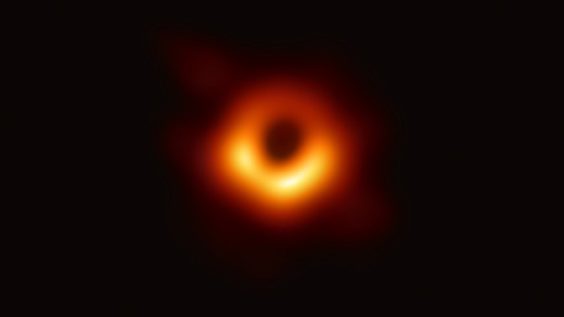
(The Atlantic) Until now, no one had actually seen a black hole, though black holes have long been a mesmerizing staple of astronomy class. Researchers today released the first-ever direct image of a black hole—one of the darkest spots in the cosmos, with a gravitational pull so strong that anything that approaches it is quickly devoured. This photogenic black hole, known as Messier 87, is 6.5 billion times the size of the sun and 55 million light-years away. The photo, in all its blurry smudges of black and orange, is a gargantuan scientific achievement that required a team of researchers to wade though 1,000 hard drives’ worth of data to stitch together one composite photo.
The Future of Black Hole Photography: What’s Next for the Event Horizon Telescope
(Space.com) The researchers who captured the first-ever images of a black hole don’t plan to rest on their laurels.
Yesterday (April 10), the Event Horizon Telescope (EHT) collaboration announced that it had photographed the contours of the supermassive black hole at the heart of M87, a huge elliptical galaxy that lies 55 million light-years from Earth.
Those contours outline the black hole’s event horizon, the famous point of no return beyond which nothing, not even light, can escape.
The epic achievement further bolsters Einstein’s theory of general relativity, which describes gravity as a consequence of the warping of space-time. And the newly unveiled images should help scientists better understand how black holes tick, and how the biggest ones — such as the M87 monster, which harbors the mass of 6.5 billion suns — shape the evolution of their host galaxies, scientists said.
What Exactly Is a Black Hole Event Horizon (and What Happens There)?
Katie Bouman: the 29-year-old whose work led to first black hole photo
Bouman is a post-doctoral fellow at MIT whose algorithm led to an image of a supermassive black hole
Katie Bouman was a PhD student in computer science and artificial intelligence at the Massachusetts Institute of Technology (MIT) when, three years ago, she led the creation of an algorithm that would eventually lead to an image of a supermassive black hole at the heart of the Messier 87 galaxy, some 55m light years from Earth, being captured for the first time.
28 March
 NASA’s shifting priorities, thanks to POTUS
NASA’s shifting priorities, thanks to POTUS
(Axios) The lunar landing by 2024 directive means that NASA now has a new top-level goal, which will affect everything from spending decisions to rocket testing protocols. It also means that yet again, a new administration has given the space agency new marching orders.
Background: NASA has been buffeted by changing priorities from administration to administration.
A poster child for this is NASA’s Constellation program to return astronauts to the moon in 2020 and subsequently launch Mars missions.
The Obama administration canceled it after a blue-ribbon commission concluded the program had been chronically underfunded and needed a massive cash infusion.
Context: The moon has never left NASA’s sights even after Eugene Cernan boarded the last crew capsule to leave the lunar surface in 1972. Presidents George H.W. Bush, Clinton, George W. Bush and Obama all maintained a return to the moon and then eventually deeper into space, including to Mars, as a target.
What’s new is the timetable and complex technological components involved.
The bottom line: While Pence’s speech may have caused heartburn for many NASA workers, it thrilled the spaceflight industry. Tommy Sanford, executive director of the Commercial Spaceflight Federation, says the administration’s new timetable is doable and will be beneficial for the pubic and private sectors.
1 March
(The Atlantic) A SpaceX launch scheduled for early Saturday will be the first time the Elon Musk-helmed company is sending up a spacecraft intended to transport humans. (An actual person won’t be on board this time, but rather a sensor-laden mannequin named Ripley.) If the mission goes well, astronauts could be headed to space in SpaceX spacecraft as early as July. No astronaut has gone to space on U.S. soil since the space-shuttle program was put on hiatus in 2011. Currently, American astronauts can only get to space through a launchpad in the middle of the Kazakh desert, which costs the U.S. both millions of dollars—and prestige. If Saturday’s launch is successful, it could spark a new era in human spaceflight where the commercial sector, not NASA, plays the leading role.
3 January
China lands spacecraft on the far side of the moon, a historic first
(WaPost) In a first for the world, China has successfully landed a spacecraft on the far side of the moon, the China National Space Administration said Thursday as the nation announced its arrival as a bona fide space power.
The probe, named Chang’e 4, launched from southwest China in early December and landed at 10:26 a.m. Beijing time Wednesday in Von Karman crater within the moon’s South Pole-Aitken basin, the largest known impact crater in the solar system. Shortly after landing, a rover on the landing craft dispatched the first photo of the moon’s surface from its far side back to Earth via a satellite communication relay.
1 January
NASA’s New Horizons Spacecraft Is Triumphant in Encounter With the Most Distant Object Ever Visited
Now scientists await clearer pictures and a bounty of new data about a small, mysterious icy body four billion miles from Earth.
Thirty-three minutes into the new year, scientists, engineers and well-wishers here at the Johns Hopkins Applied Physics Laboratory celebrated the moment that NASA’s New Horizons spacecraft made its closest approach to a small, icy world nicknamed Ultima Thule.
Almost 10 hours later, the New Horizons team finally received confirmation that the spacecraft had executed its planned observations flawlessly. In the days and months to come, the mission’s scientists expect to receive pictures of Ultima Thule and scientific data that could lead to discoveries about the origins of the sun and the planets.
That is the latest triumph in a journey that started in 2006, when the spacecraft launched on a mission to explore Pluto. Thirteen years and more than four billion miles later, New Horizons has provided humanity’s first glimpse of a distant fragment that could be unchanged from the solar system’s earliest days.
Ultima Thule, the name that the mission team selected for the object from more than 34,000 suggestions from the public, means “beyond the borders of the known world.” (Thule is pronounced “TOO-lee.”)
2018
2018: The year of the solar system explorer
(Axios) With a half dozen major planetary exploration missions launching or approaching their targets this year, the solar system is going to be a busy place:
India’s lunar lander and rover, Chandrayaan-2, will launch in March.
NASA leads a return to the Red Planet in May with the departure of its Insight lander.
Japan’s Hayabusa 2 and NASA’s OSIRIS-REx missions will arrive at their respective asteroid targets this summer.
The European Space Agency’s BepiColombo orbiter will depart for Mercury in October.
What’s next: These missions will return a bounty of information on the history of Mars, the curious properties of Mercury’s interior, and even the origins of the solar system itself. Of course, every question answered could prompt at least a dozen more.
Searching for planets near and far
The search for planets beyond our solar system will be taken up by the Transiting Exoplanet Survey Satellite, a new NASA spacecraft scheduled to launch in the first half of the year that will focus on finding exoplanets around bright stars and those close to Earth.
Its predecessor — NASA’s Kepler missions — discovered more than 2,500 confirmed exoplanets, including two recently spotted with artificial intelligence. Researchers plan to use machine learning to scour more data from Kepler in search of planets that may have been overlooked.
8 September
What the Heck Happened on the International Space Station?
The puzzling story of a mysterious malfunction 250 miles above Earth
(The Atlantic) The quick response to the mysterious malfunction and the seemingly collaborative effort to investigate it serves as a reminder of the good relations between the United States and Russia where the International Space Station is concerned. That kind of thing is pretty rare down on Earth. Neither nation would be able to carry out this task—operating and maintaining the biggest artificial structure in low-Earth orbit—alone. They need each other’s technology, and they need each other’s money.
30 August
Astronauts repair hole in wall of International Space Station
(CBC) The problem was first detected by mission control Wednesday night as a reduction of pressure in the station, but it was small enough that the crew was allowed to sleep all night, NASA reported.
14 August
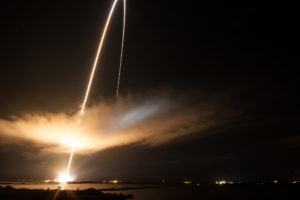 A Fireball and a Wall of Sound: What NASA’s Epic Solar Probe Launch Felt Like
A Fireball and a Wall of Sound: What NASA’s Epic Solar Probe Launch Felt Like
(Space.com) Mars hung low over my shoulder, close and bright and fiery, as I stood on a causeway across the Banana River Sunday (Aug. 12) here at Cape Canaveral Air Force Station. A slight breeze kept the mosquitoes away, and Perseid meteors popped up every now and again, carving brief and slender slivers of light into the predawn sky.
And then, at 3:31 a.m. EDT (0731 GMT), that dark sky lit up in a flash of brilliant orange as a United Launch Alliance Delta IV Heavy rocket, one of the most powerful boosters flying today, lifted off the pad.
If all goes according to plan, the Parker Solar Probe will fly through the sun’s outer atmosphere, or corona, 24 times over the next seven years. The spacecraft will get within 3.83 million miles (6.16 million kilometers) of the solar surface, zooming through space at up to 430,000 mph (690,000 km/h) during these close flybys.
Both of those figures will shatter spaceflight records: No other spacecraft has ever gotten closer to the sun than 27 million miles (43 million km) or traveled faster than 165,000 mph (265,000 km/h).
The data gathered by the Parker Solar Probe during these close encounters should help scientists solve some long-standing solar mysteries, NASA officials have said — for example, why the corona is so much hotter than the solar surface, and how the particles that make up the solar wind are accelerated to their tremendous speeds. (These subatomic bits are moving between 900,000 mph and 1.8 million mph, or 1.45 million and 2.9 million km/h, by the time they reach Earth.)
10 August
One man’s moment in the sun. The Parker Solar Probe set to launch this weekend is the first NASA spacecraft named after a living person. At 31, Eugene Parker revolutionized solar physics with his ideas—but as the New York Times’ Kenneth Chang reports, no one believed him at the time.
NASA’s Parker Solar Probe Is Named for Him. 60 Years Ago, No One Believed His Ideas About the Sun.
Eugene N. Parker predicted the existence of solar wind in 1958. The NASA spacecraft is the first named for a living person.
In a foundational paper published in The Astrophysical Journal, Dr. Parker described how charged particles streamed continuously from the sun, like the flow of water spreading outward from a circular fountain.
The scientists who had reviewed the paper rejected his idea as ludicrous. Dr. Parker appealed to the journal’s editor, Subrahmanyan Chandrasekhar, a prominent astrophysicist also at Chicago, arguing that the reviewers had not pointed out any errors, just that they did not like the premise.
Dr. Chandrasekhar overruled the reviewers.
Space Force: all you need to know about Trump’s bold new interstellar plan
Mike Pence announced on Thursday a new military branch dedicated to fighting wars in space – but what is Space Force?
(The Guardian) The United States Space Force, as proposed by the Trump administration, would be a new branch of the military by 2020, on par with the army, navy, air force, marines and coast guard. An independent branch can’t be created until Congress approves it, but the administration can take several steps on its own to prepare for the launch of a new force, the first since the air force was formed shortly after the second world war.
Officials plan to create a Space Operations Force – an “elite group of war fighters specializing in the domain of space” drawn from various branches of the military, in the style of existing special operations forces, Pence said. They’ll also create a United States Space Command and a Space Development Agency, and appoint an assistant secretary of defense for space.
General Barry McCaffrey: ‘Space Force Is A Thoroughly Stupid Idea’
Trump Wants a Space Force — But We Have an Air Force Space Command
(Space.com) President Donald Trump’s administration is pushing to form a U.S. Space Force, a new military branch, but how would that agency differ from the Air Force Space Command, which already oversees much of the country’s defense assets in space?
In a speech at the Pentagon Thursday (Aug. 9), Vice President Mike Pence revealed a detailed plan to create the Space Force, which Trump proposed earlier this yearn. The Space Force swill meet “the rising security threats our nation faces in space today and in the future,” Pence said. If approved by Congress, the Space Force could be ready by 2020, he added.
But the proposed Space Force is not the United States’ first foray into militarizing space. The first U.S. rockets were launched by the U.S. military, and NASA’s first astronauts were military officers, Pence said. And in 1982, the U.S. Air Force established the Air Force Space Command (AFSPC) to provide “space capabilities” for spaceflight missions, navigation, satellite communications, missile warning and space control, according to AFSPC’s website.)
5 May
(Quartz) The first US mission to Mars in five years may be the start of a new wave of exploration, as geopolitics and the private space industry pressure NASA to move faster. Global space agencies are planning five missions to Mars that are expected to launch in 2020, including a new US rover.
Meanwhile, the Trump administration called for a return to the moon, and then cancelled a planned NASA-designed rover in favor of hiring private companies to transport scientific instruments to the moon using vehicles of their own design, upsetting scientists who worked on the program. NASA is looking at plans to finance deep-space exploration by ending its work on the International Space Station in the next decade, possibly handing it over to one or more private companies.
Future missions will need to improve on the current record: InSight missed its original launch window in 2016 after a seismometer designed by France’s space agency failed in tests. This week, the oft-delayed James Webb Space Telescope project announced that it may face further slips in schedule after vibration tests that simulate the stress of a launch led to screws and washers falling off.
On April 16, Elon Musk’s SpaceX launched a NASA satellite on a mission to hunt alien worlds. Next week, his company will fly the final version of its reusable Falcon 9 rocket, as Musk begins to focus on developing a larger interplanetary vehicle to send humans to Mars. Last weekend, Jeff Bezos’ Blue Origin launched its reusable rocket for the eighth time, with plans to fly human test pilots within the next year. All this as private funding is flowing to satellite builders and rocket-makers.
Scientists are concerned that they will be left out of a space revolution driven by private companies. Yet the model is not so different from today: Lockheed Martin, after all, built and will operate the InSight spacecraft, with researchers from around the world contributing scientific tools. And NASA science leaders like Thomas Zurbuchen are pushing for ambitious missions with cheap hardware—tiny cubesats—pioneered by private companies. In a perfect world, cheaper access to space should enable scientific exploration, not diminish it.
The real question is whether space agencies will continue demanding that aerospace companies act like bureaucracies, or if bureaucrats will learn from the new space companies and return to their roots—acting more like the tech startup NASA was when it got humans to the moon in the first place.—Tim Fernholz
29 April
NASA, committed to lunar exploration, is shutting down a moon rover mission
NASA said on April 27 that it was developing an exploration strategy, in line with Trump’s directive, to meet its expanded lunar exploration goals. The agency noted some instruments from Resource Prospector will still be utilized, and that it’s planning a series of robotic missions to the lunar surface.
26 April
China lays out its ambitions to colonize the moon and build a “lunar palace”
(Quartz) The proposed lunar outpost would be made of multiple tube-shaped cabins where scientists would live and conduct their research. The agency didn’t provide a specific timeframe, but Wu Weiren, the chief designer of China’s moon-exploration project, told state broadcaster CCTV in March that it could happen by 2030 (link in Chinese). The ideal location would be the moon’s south pole, which might have water and enough sunlight, he added.
16 April
SpaceX launches an observatory to hunt alien planets
TESS’s job is to spot distant planets when they pass in front of even more distant stars, a movement known to astronomers as a “transit.” The MIT researchers behind the project expect to catalog thousands of new planets smaller than Neptune, and perhaps dozens comparable to Earth, which can then be studied with other instruments. This is the first time that humans have used an orbiting surveyor to search nearly the entire sky for new planets, compared to previous efforts that have scanned just a tiny percentage of what we can see.
Ultimately, this is part of a broad effort by NASA, MIT and scientists around the world to scout out planets that may suitable for human—or other—life.
2017
15 September
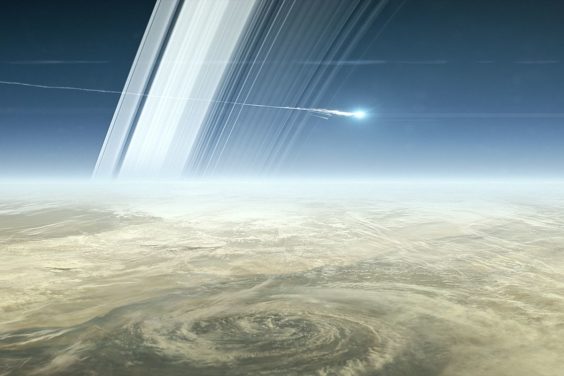 An artist’s rendition of what Cassini’s crash into Saturn will look like. NASA/JPL-Caltech
An artist’s rendition of what Cassini’s crash into Saturn will look like. NASA/JPL-Caltech
(Quartz) Cassini’s grand finale. After a 20-year journey, the space probe will send a few last snippets of scientific data as it hurtles into Saturn—an act of altruistic suicide to avoid contaminating moons that may contain life. You can follow its final moments here.
RIP, Cassini: Historic Mission Ends with Fiery Plunge into Saturn
(Space.com) Cassini’s descent into Saturn was intentional. The spacecraft was rapidly running out of fuel, after spending nearly 20 years in space, and NASA scientists decided to make use of the mission’s inevitable conclusion. By crashing into Saturn, Cassini had the opportunity to see what the planet’s upper atmosphere is made of, and that’s the data that the probe sent back to Earth during its final few moments of life. The probe took its last images of the Saturn system yesterday (Sept. 14), and transmitted those images back to Earth the same day, ahead of its plunge.
The Cassini spacecraft crashed into Saturn, ending a successful 20-year mission
It’s precisely because of its successes that Cassini had to die. Once the spacecraft ran out of fuel, NASA would not risk letting it remain aloft, where it might be knocked into Titan or Enceladus.
(WaPost) NASA scientists just received their last message from the Cassini spacecraft, which plunged into Saturn early Friday morning. Those final bits of data signal the end of one of the most successful planetary science missions in history.
“The signal from the spacecraft is gone and within the next 45 seconds so will be the spacecraft,” program manager Earl Maize reported from mission control at NASA’s Jet Propulsion Laboratory, just after 4:55 a.m. local time. “This has been an incredible mission, an incredible spacecraft, and you’re all an incredible team.”
7 May
Unmanned U.S. Air Force space plane lands after secret, two-year mission
(Reuters) The U.S. military’s experimental X-37B space plane landed on Sunday at NASA’s Kennedy Space Center in Florida, completing a classified mission that lasted nearly two years, the Air Force said.
The unmanned X-37B, which resembles a miniature space shuttle, touched down at 7:47 a.m. EDT (1147 GMT) on a runway formerly used for landings of the now-mothballed space shuttles, the Air Force said in an email.
The Boeing-built space plane blasted off in May 2015 from nearby Cape Canaveral Air Force Station aboard an Atlas 5 rocket built by United Launch Alliance, a partnership between Lockheed Martin Corp (LMT.N) and Boeing Co (BA.N).
The X-37B, one of two in the Air Force fleet, conducted unspecified experiments for more than 700 days while in orbit. It was the fourth and lengthiest mission so far for the secretive program, managed by the Air Force Rapid Capabilities Office.
(Quartz) Scientists have discovered nearly 3,500 planets that circle a star other than our sun. And, yet, something about the announcement of seven new exoplanets this week seemed to have struck a chord with millions of people in ways the previous thousands did not. … Trappist-1 is an ultra-cool dwarf star, one of the most common types of star in our galaxy. Finding Earth-like planets around one of these stars means we likely have billions of Earth-like planets in the Milky Way alone. And with every exoplanet we discover, the probability that we’re alone in the universe goes down. But to many detractors, this sort of space research is a waste of taxpayers’ money. Knowing there are Earth-like planets some 39 light years away, a distance we’re unlikely to cross any time soon, does not in any way alleviate the many terrestrial problems we face today. That argument gets even stronger when serious money is spent on space by a country like India, which launched a successful mission to Mars, but still has hundreds of millions suffering in poverty.
It’s hard to put a number on the return on investment in space research, but experts agree that benefits far outweigh costs.
23 February
What life would be like on the seven newly discovered Earth-like planets
(Quartz) We’ve found a new solar system, and it threatens to put our own to shame. The star Trappist-1, a mere 39 light years away, has been found to host seven Earth-sized, rocky planets.
The discovery has astronomers, alien-hunters, and space enthusiasts abuzz for a good few reasons. Among new solar systems discovered so far, none have had more than seven planets (our system has eight). And none have had all seven that were rocky and also Earth-sized.
What’s more, because the star type is among the most common in our galaxy, such solar systems are likely to be quite common. That makes the Trappist-1 system a prime target to accelerate the search for life beyond our own solar system.
Even though our sun is a much larger star than Trappist-1, our planets are so far apart that their conditions range from the scorching hot world of Mercury to the bitter icy gases of Uranus. Instead, planets Trappist-1b to Trappist-1h are nestled together cosily around an “ultracool” dwarf star, and that means each likely has temperate conditions and thus possibly liquid water in some regions.
Humans have been struggling to land on Mars. Instead, if intelligent aliens live on any one of Trappist-1 planets (and you bet scientists are already searching), flying from one to another would be a quick jaunt, relatively speaking. “It’s both easy and tempting to envision a multi-world empire arising in this star system, a small federation of planets in our cosmic backyard,” writes Seth Shostak, director of the SETI Institute.
22 February
Astronomers find seven Earth-size planets where life is possible
(Reuters) Astronomers have found a nearby solar system with seven Earth-sized planets, three of which circle their parent star at the right distance for liquid surface water, bolstering the prospect of discovering extraterrestrial life, research published on Wednesday showed.
The star, known as TRAPPIST-1, is a small, dim celestial body in the constellation Aquarius. It is located about 40 light years away from Earth, close by astronomical standards, but about 44 million years away at the average cruising speed of a commercial passenger jet.
Researchers said the proximity of the system, combined with the proportionally large size of its planets compared to the small star, make it a good target for follow-up studies. They hope to scan the planets’ atmospheres for possible chemical fingerprints of life.
“The discovery gives us a hint that finding a second Earth is not just a matter of if, but when,” NASA chief scientist Thomas Zurbuchen said at a news conference on Wednesday.
TRAPPIST-1: How Long Would It Take to Fly to 7-Planet System?
With today’s technology, there’s no way that anyone alive right now could make it to TRAPPIST-1 in a lifetime. While discussing the new discovery at a news conference today (Feb. 22), NASA officials suggested that it would likely take at least 800,000 years to reach the TRAPPIST-1 system.
19 February
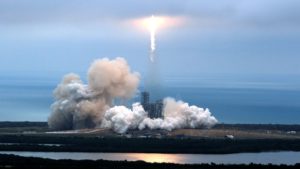 SpaceX had a successful and historic launch. A day after its launch was postponed with 13 seconds left on the clock, a Falcon 9 rocket took off from Kennedy Space Center at 9:38am ET on Sunday from a pad that hadn’t seen a liftoff in six years. NASA described the launch, which will deliver supplies to the International Space Station, as the beginning of a new phase of American operations in space.
SpaceX had a successful and historic launch. A day after its launch was postponed with 13 seconds left on the clock, a Falcon 9 rocket took off from Kennedy Space Center at 9:38am ET on Sunday from a pad that hadn’t seen a liftoff in six years. NASA described the launch, which will deliver supplies to the International Space Station, as the beginning of a new phase of American operations in space.
4 January
Enigmatic Radio Pulses Linked to Far-Distant Galaxy
Pinpointing a source for “fast radio bursts” brings scientists one step closer to solving a cosmic mystery
(Scientific American) Astronomers have pinpointed the location of an enigmatic celestial object that spits out brief, but powerful, blasts of radio waves. Surprisingly, the source of these intermittent signals lies not in a bright galaxy but in a small, dim one, some 2.5 billion light-years from Earth.
The bursts were first spotted by the Parkes radio telescope in New South Wales, Australia, and fewer than 20 have been found so far. Most were discovered in wide-field searches that cannot pinpoint exactly where they come from — which makes it harder for astronomers to winnow down possible explanations for what causes them.
2016
14 December
Speaking of Star Wars: One way to search for extraterrestrial intelligence might be to look for alien defense shields. In a new report, two astronomers argue that advanced civilizations elsewhere in the universe could build shields against exploding stars out of objects in their solar systems—and that such shields could be detected by humans’ powerful telescopes. Meanwhile, Earth is in need of its own defenses: Scientists say the planet is unprepared for a comet collision, which, if it happened, could wipe out humans and other species. Comets move fast enough that NASA wouldn’t have time to build spacecraft after a hazardous one was detected—which is why some researchers have a plan to build comet-destroying spacecraft in advance.
21 October
(Quartz) Russia is one of two nations (the other is China) currently capable of putting humans into space, and at that job it’s been spectacularly reliable. Without Russia’s Soyuz rockets, there would be no US astronauts aboard the International Space Station (ISS). But on other fronts the once mighty Russian (previously Soviet) space program has floundered. Its last successful interplanetary mission was to Venus in 1984. With Mars, it’s had a string of almost unmitigated failures since its first attempted flyby in 1960.
At its height, Soviet spending on space rivaled America’s (pdf, p. 5). But now Roscosmos’s budget for the coming decade is equal to NASA’s for a single year. The $7.5 billion Vostochny Cosmodrome—a new launch site intended to restore Roscosmos’s glory—has been hit with spiraling costs, delays, strikes, and even admissions of embezzlement. Russia has also had to delay an ambitious new moon program, which includes building a lunar complex and orbital station. Worse still, Roscomos’s lucrative contracts to send NASA astronauts to the ISS may not continue beyond 2017, when SpaceX or Boeing start human launches.
So ExoMars matters a lot to Roscosmos. The mission’s next phase involves sending a rover to Mars in 2021. ESA is to build the rover while Roscosmos is to redesign the failed landing gear based on the data gathered this week. If that mission fails too, it’ll wound ESA’s pride, but it could ruin Russia’s.—Akshat Rathi
20 October
Crash landing feared as Europe’s Mars lander still silent
(CBC) Unclear if Schiaparelli probe touched down as planned, or crashed into Red Planet
(QUARTZ) The European Space Agency lost contact with its Mars lander. The Schiaparelli craft, designed to test new landing equipment, went ominously silent after its descent to the planet’s surface. On the bright side, the agency’s TGO satellite achieved the correct orbit, and will search the atmosphere for the chemical signatures of life.
13 October
Updates from ESA’s space operations centre as the ExoMars Trace Gas Orbiter approaches and enters orbit around the Red Planet, and the Schiaparelli module lands on its surface
Updates on this page will cover the following expected milestones:
14 October: TGO final trajectory manoeuvre (08:45 GMT)
16 October: Separation of Schiaparelli from TGO at 14:42 GMT / 16:42 CEST
17 October: TGO orbit-raising manoeuvre at 02:42 GMT / 04:42 CEST
19 October: TGO Mars orbit insertion and Schiaparelli entry, descent and landing on Mars (atmospheric entry expected 14:42 GMT / 16:42 CEST, landing 14:48 GMT / 16:48 CEST)
20 October: Update on Schiaparelli status; descent images expected
21+ October: Schiaparelli status reports until end of mission
Note: Times shown above are actual event times at Mars; the one-way signal travel time between Earth and Mars is currently just under 10 minutes.
What is ExoMars?
(ESA) The ExoMars programme is a joint endeavour between ESA and the Russian space agency, Roscosmos.
The primary goal of the ExoMars programme is to address the question of whether life has ever existed on Mars. This relates to its name, with the ‘exo’ referring to the study of exobiology – the possible existence of life beyond Earth (sometimes also referred to as astrobiology).
The programme comprises two missions. The first will be launched in March 2016 and consists of the Trace Gas Orbiter (TGO) and Schiaparelli, an entry, descent and landing demonstrator module. The second is planned for launch in 2020 and comprises a rover and surface science platform.
30 September
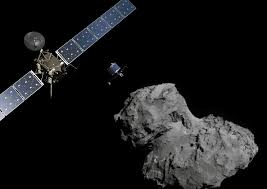 Mission complete
Mission complete
ESA’s historic Rosetta mission has concluded as planned, with the controlled impact onto the comet it had been investigating for more than two years.
Confirmation of the end of the mission arrived at ESA’s control centre in Darmstadt, Germany at 11:19 GMT (13:19 CEST) with the loss of Rosetta’s signal upon impact.
Rosetta carried out its final manoeuvre last night at 20:50 GMT (22:50 CEST), setting it on a collision course with the comet from an altitude of about 19 km. Rosetta had targeted a region on the small lobe of Comet 67P/Churyumov–Gerasimenko, close to a region of active pits in the Ma’at region.
“Thanks to a huge international, decades-long endeavour, we have achieved our mission to take a world-class science laboratory to a comet to study its evolution over time, something that no other comet-chasing mission has attempted,” notes Alvaro Giménez, ESA’s Director of Science.
Rosetta Mission Ends With Spacecraft’s Dive Into Comet with video
(NYT) Rosetta, the first spacecraft to orbit a comet, is dead, setting down in a final embrace with its companion of the past two years.
Radio signals from Rosetta flatlined at 7:19 a.m. Eastern after it did a soft belly-flop onto Comet 67P/Churyumov-Gerasimenko at a speed of two miles per hour, slower than the average walk.
For the last few minutes, people at the European Space Operations Center in Darmstadt, Germany, watched their computer screens mostly in silence, but with some nervous chatter. When the radio signals ceased, they applauded and hugged in a celebration that was part joyous, part somber.
5 September
Rosetta finally finds Philae lander’s dark hiding place on a distant comet
The European Space Agency’s orbiter has been searching for months for its lost robotic buddy and can now prepare for an eternal reunion at the end of September.
(CNET) After nearly two years hidden in limbo on a comet racing around the sun, the European Space Agency’s Philae lander has finally been found, and just in the nick of time as the search window for the Rosetta spacecraft traveling alongside Comet 67P/Churyumov-Gerasimenko will soon close.
If you’re not a space nut, you probably haven’t heard all these names since late 2014 when Rosetta rendezvoused with the comet and deployed Philae to its surface for a closer look. The mission went well at first, until Philae touched down on the comet, bounced and landed in a dark crevasse where it was unable to receive enough solar power to charge its batteries.
Once its batteries were depleted after a couple days, Philae was essentially lost. The lander briefly awoke for a moment last year when the comet traveled closer to the sun, but then all went dark again. In July of this year the mission crew finally gave up all hope of re-establishing communication with the wayward Philae.
4 September
SpaceX’s Explosion Reverberates Across Space, Satellite and Telecom Industries
(NYT) The explosion of a SpaceX rocket last Thursday will have an impact across the space industry, far beyond the losses on the launchpad at Cape Canaveral, Fla.
An Israeli satellite operator’s deal to sell itself to a Chinese company is imperiled. Planned launches of communications satellites that support international mobile phone service and digital television are delayed and put in doubt. NASA’s cargo deliveries to the International Space Station will probably be disrupted.
All of them are customers of the Space Exploration Technologies Corporation, or SpaceX. The private space launch company, led by the entrepreneur Elon Musk, has a generally solid safety record.
But last week’s setback and a failed launch last year, when its rocket carrying a NASA cargo fell apart in flight, are raising questions about SpaceX, a company that has risen rapidly by offering lower costs and promising accelerated launch schedules.
2 September
SpaceX rocket explosion: Mark Zuckerberg laments loss of Internet.org satellite
Writing on his Facebook page, Zuckerberg said: “As I’m here in Africa, I’m deeply disappointed to hear that SpaceX’s launch failure destroyed our satellite that would have provided connectivity to so many entrepreneurs and everyone else across the continent.”
The accidental explosion of the Falcon 9 rocket early on Thursday morning – referred to as an “anomaly” by SpaceX engineers – destroyed both the rocket and its cargo: the AMOS-6 satellite, which Facebook had planned to deploy to provide internet coverage to parts of Africa.
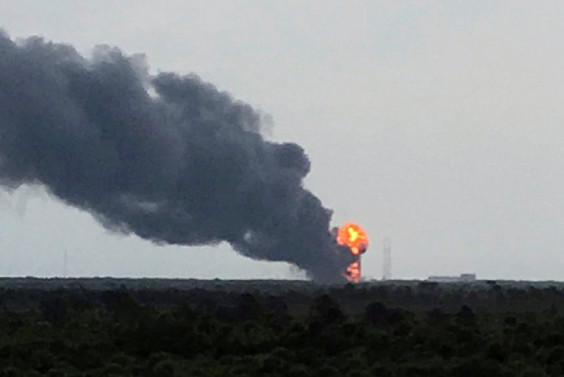
1 September
A rocket SpaceX was testing exploded on a launch pad in Florida
(Business Insider) SpaceX was testing a Falcon 9 rocket at a Cape Canaveral launch pad when it was rocked by powerful explosions.
SpaceX was scheduled to do a static test-fire of a 229-foot-tall Falcon 9 rocket with no crew aboard it on Thursday morning, when it exploded shortly after 9 a.m. EDT on Thursday, Sept. 1, 2016, the company said. (A “static fire” is when they test-fire the rocket’s engines without actually launching it into the air.
24 August
Discovery of potentially Earth-like planet Proxima b raises hopes for life
Thought to be at least 1.3 times mass of Earth, planet lies within ‘habitable’ zone of Proxima Centauri, raising hopes for life outside our solar system
The search for life outside our solar system has been brought to our cosmic doorstep with the discovery of an apparently rocky planet orbiting the nearest star to our sun.
Thought to be at least 1.3 times the mass of the Earth, the planet lies within the so-called “habitable zone” of the star Proxima Centauri, meaning that liquid water could potentially exist on the newly discovered world.
Named Proxima b, the new planet has sparked a flurry of excitement among astrophysicists, with the tantalising possibility that it might be similar in crucial respects to Earth.
13 – 15 August
 The New Yorker Sent Star Wars Actor Kenny Baker Off Right
The New Yorker Sent Star Wars Actor Kenny Baker Off Right
(Popular Science) Cartoon remembers the R2-D2 actor, hits us where it hurts
Oh man, it’s a good thing droids can’t cry because we’d have a lot of rusty sensors out there right now.
Star Wars: 15 Facts You Didn’t Know About R2-D2
R2-D2 is the unsung hero of the Star Wars franchise; the little droid has fought alongside multiple generations of Skywalkers, and has been an integral part of the Galactic Senate’s fight in the Clone Wars and later the Rebel Alliance’s fight for freedom. Stubborn, loyal, and resourceful, R2-D2 (or Artoo) is always there to save the day and his friends (especially C-3PO – okay, mostly Threepio). It turns out, though, that the droid at the heart of the Star Wars story has some surprises.
Kenny Baker, actor behind R2-D2, dies
The 3ft 8in actor, who starred in six Star Wars films as well as Time Bandits and Flash Gordon, was 81
He went on to play the character in The Empire Strikes Back and Return of the Jedi, as well as the three Star Wars prequels from 1999 to 2005. He also appeared in a number of other much loved films in the 1980s, including The Elephant Man, Time Bandits and Flash Gordon.
12 August
European Space Agency targets Mars for October landing of Schiaparelli module
ESA plans to build on the legacy of British Mars lander Beagle 2 by placing the Schiaparelli module on the Red Planet in October
The region has been well studied from orbit and shows good evidence of once having been covered in water. There are clay sediments and sulphates that were likely formed in the presence of water, and a number of water-carved channels.
Although Schiaparelli is designed primarily to test entry, descent and landing, it does carry a number of scientific sensors. It will essentially be a martian weather station, designed to return key information about what initiates the dust storms that engulf the planet every martian spring.
Launched on 14 March 2016, it will enter Martian orbit in October and begin a comprehensive study of the planet’s atmosphere that will last until at least 2022.
23 July
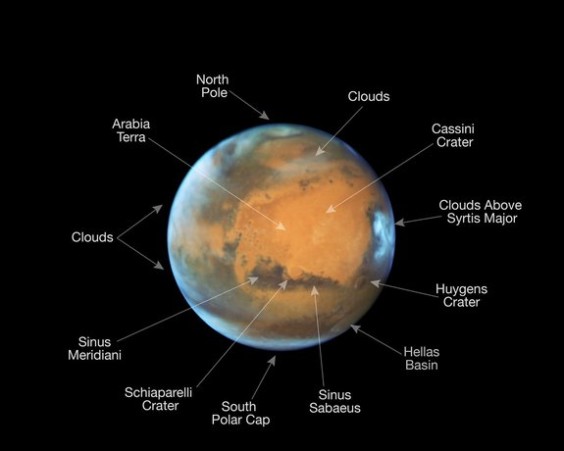
This image shows our neighbouring planet Mars, as it was observed shortly before opposition in 2016 by the NASA/ESA Hubble Space Telescope. Some prominent features on the surface of the planet have been annotated.
Forty years of missions to Mars
Four decades after Nasa’s Viking 1 landed on the red planet, we detail every Mars mission to date – successful or not
(The Guardian) Getting to Mars still isn’t easy. In the 40 years since the successful Nasa mission, there have been 18 attempts to reach the planet (excluding a joint European Space Agency (ESA)/Russian mission, which is currently en route).
Of those 18 missions, just half were fully successful. All but one of them were launched by the US, the exception being India’s successful Mars Orbiter mission, which arrived in September 2014 and continues to operate.
Two other missions achieved partial success. The USSR’s Phobos 2 mission, launched in 1988, successfully achieved orbit, although its lander and hopper failed to reach Phobos, one of the planet’s two moons.
The ESA’s Mars Express, which achieved orbit in 2003, has imaged 95% of the surface of the planet and taken various measurements, hugely expanding our knowledge. The mission successfully carried and released the UK-built Beagle 2, but nothing was heard from the lander after it touched down. The ESA declared the lander lost in 2004. However, in 2015, it was spotted in images taken by a NASA orbiter.
Hubble Telescope Captures Incredible Up-Close View of Mars (19 May)
16 May
Meet David Saint-Jacques, the next Canadian headed to space
Quebec City native recalls being amazed by night sky as a young boy
(CBC) Born in Quebec City and raised in St-Lambert on Montreal’s South Shore, Saint-Jacques has a background in engineering, astrophysics and medicine.
During his studies, he completed:
a Ph.D. in astrophysics from Cambridge University.
an M.D. from Université Laval in Quebec City.
family medicine residency at McGill University.
As well, Saint-Jacques, who is married and has two children, is fluent in English and French and can also speak Russian, Spanish and Japanese, according to his Canadian Space Agency profile.
He is also a lifelong mountaineer, cyclist, skier and avid sailor, and holds a commercial pilot licence and advanced scuba-diving licence.
Meet Canadian Astronaut David Saint-Jacques
(Canadian Space Agency) As a kid, David Saint-Jacques travelled the world with his family, fostering his spirit of exploration, openness, curiosity and caring for others. An engineer and strophysicist, David later became a family physician and practiced medicine in the Canadian Arctic.
On May 13, 2009, he was recruited by the Canadian Space Agency as one of two new astronauts after a year-long process. Get to know David better with this video profile produced on the occasion of the 5th anniversary of his recruitment.
11 March
Astronaut Scott Kelly to Retire from NASA in April
NASA astronaut and one-year crew member Scott Kelly will retire from the agency, effective April 1. Kelly joined the astronaut corps in 1996 and currently holds the American record for most time spent in space. After retiring, Kelly will continue to participate in the ongoing research related to his one-year mission. He will provide periodic medical samples and support other testing in much the same way that his twin brother, former astronaut Mark Kelly, made himself available for NASA’s Twins Study during his brother’s mission.
NASA Astronaut Scott Kelly Returns to Earth after One-Year Mission
After spending 340 consecutive days in space, NASA astronaut Scott Kelly is back on Earth. Kelly landed safely in Kazakhstan at 11:26 p.m. ET on March 1, 2016.
